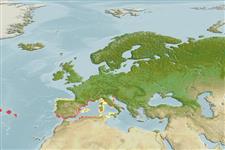>
Gobiesociformes (Clingfishes) >
Gobiesocidae (Clingfishes and singleslits) > Lepadogastrinae
Etymology: Apletodon: Greek, aplatos, apletos = terrible + Greek, odous = teeth (Ref. 45335).
Environment: milieu / climate zone / depth range / distribution range
Écologie
marin démersal; profondeur 2 - 19 m (Ref. 28715). Subtropical; 45°N - 36°N, 32°W - 14°E
Mediterranean Sea: Rovinj and Premantura (Istria, northern Adriatic Sea), around Elba (Italy), Ibiza (Baleares), Banyuls-sur-Mer (southern France). Northeast Atlantic: Azores.
Taille / Poids / Âge
Maturity: Lm ? range ? - ? cm
Max length : 2.7 cm SL mâle / non sexé; (Ref. 28715)
Juveniles about 1-2 cm SL are often observed in association with sea urchins and in beds of Posidonia oceanica. Adults found hidden under stones covered with red calcareous algae and empty shells of mussels near Posidonia and Cymodocea nodosa beds. Among Posidonia, the species is often sympatric with Opeatogenys gracilis (Ref. 28715).
Life cycle and mating behavior
Maturities | Reproduction | Spawnings | Egg(s) | Fecundities | Larves
Hofrichter, R. and R.A. Patzner, 1997. A new species of Apletodon from the Mediterranean Sea and the eastern Atlantic with notes on the differentiation between Apletodon and Diplecogaster species (Pisces: Teleostei: Gobiesociformes: Gobiesocidae). Senckenbergiana biol. 77(1):15-22. (Ref. 28715)
Statut dans la liste rouge de l'IUCN (Ref. 130435)
Menace pour l'homme
Harmless
Utilisations par l'homme
Outils
Articles particuliers
Télécharger en XML
Sources Internet
Estimates based on models
Preferred temperature (Ref.
123201): 17.6 - 19.2, mean 18.7 °C (based on 109 cells).
Phylogenetic diversity index (Ref.
82804): PD
50 = 0.5156 [Uniqueness, from 0.5 = low to 2.0 = high].
Bayesian length-weight: a=0.00513 (0.00202 - 0.01305), b=3.11 (2.89 - 3.33), in cm total length, based on LWR estimates for this (Sub)family-body shape (Ref.
93245).
Niveau trophique (Ref.
69278): 3.1 ±0.5 se; based on size and trophs of closest relatives
Résilience (Ref.
120179): Haut, temps minimum de doublement de population inférieur à 15 mois (Preliminary K or Fecundity.).
Fishing Vulnerability (Ref.
59153): Low vulnerability (10 of 100).
